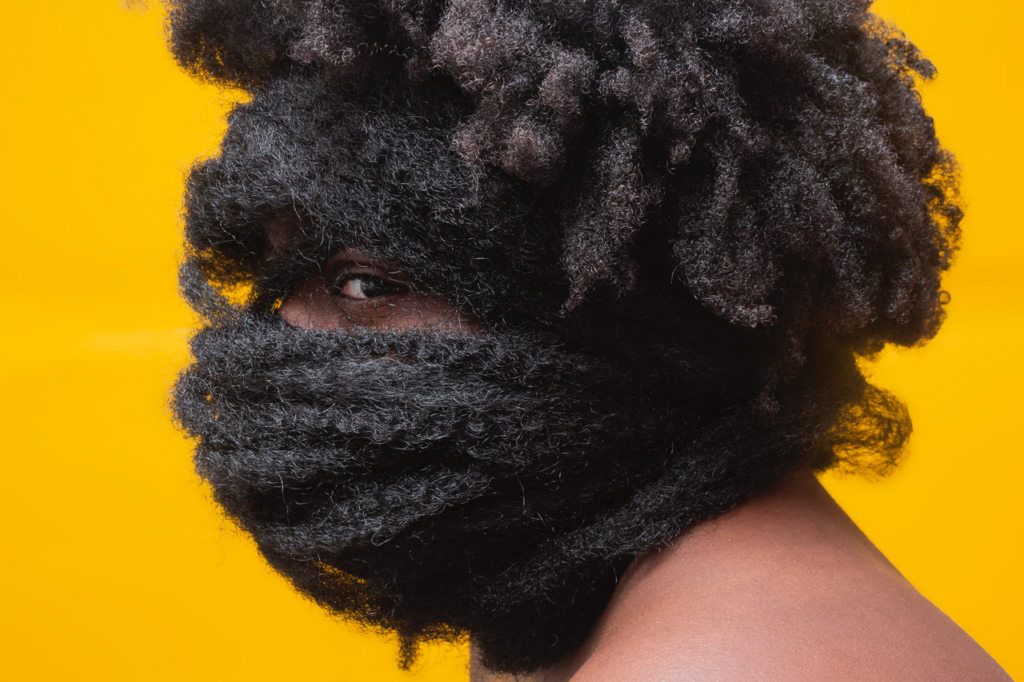
The Plumage of Another, curated by Michael Palma Mir and featuring artists Vicky Charles, Yelaine Rodriguez, Faustino Vidal, Leslie Jimenez, and Jorge Romero, examines the notion of hair, aka “plumage,” as a social signifier and an expression of individuality.
Curator, Michael Palma Mir on The Plumage of Another.
“Nothing is more indicative of the importance currently being attached to hair growth by the general populace than the barrage of cases reaching the courts evidencing the attempt by one segment of society to control the plumage of another.”
Justice William 0. Douglas
Written in 1974 about the increase in court cases adjudicating a state’s right to control the appearance of individuals purposefully flaunting social conventions through physical appearance, this Apartment Gallery Series exhibition revisits the important role hair plays for these featured photographers nearly 50 years removed from Supreme Court Justice Douglas’ still enduring concern.
The photographers selected have taken up the examination of one’s plumage in response to the never ceasing tension to control hair vis-à-vis notions of perceived beauty and ethnic identity, through the struggle against societal conformity and the need to celebrate our inherent uniqueness. No longer a matter of governmental law, these photographers, Vicky Charles, Leslie Jiménez, Yelaine Rodriguez, Jorge Romero and Faustino Vidal make their highly personalized case in demonstrating the subtle ways one segment of society continues to dominate and influence control over another’s hair. Be it on the body, face, or head, whether removed, replaced, relaxed, dyed, bound, loose, long, short, curly, straight, or synthetic, they inscribed hair with meaning as a manifestation of resolute cultural preference and strident political statement.
As if to place us back in that exact tumultuous time in our Nation’s history, Yelaine Rodriguez’ series of high key, stunning black and white portraits “Political Afro” evokes in present day faces and gazes the pluck and perseverance of individuals who before those pictured here challenged the status quo, armed only with the philosophy of nonviolence, the strength of their convictions, and the countenance of their courage. The sum of their struggles, down payment on the dignity and respect so dearly paid in the Civil Rights movement, are clearly seen in Yelaine’s emotive pictures, through the personages’ confident pose, sure expression, and compelling hair. In stylistic contrast, Vicky Charles’ colorfully whimsical photographs belies the poignancy of her messaging, of the social reckonings and multifarious kinds of wrong still afflicted upon people of color. Her curly black locks draw our attention to the race-based brutality from gassings, shootings, strangulations, of the martyrdom and sacrifices laid upon the altar of the law.
Looking at hair as a cultural extension, these photos also examine the root of identity, hair’s function as an object open to both self-promotion and communal belonging. A point of contention in Latinx and Afro Latinx culture, their photographs place hair types into two distinct categories, “pelo malo” and “pelo Bueno”. “Pelo malo” means bad hair in Spanish, and it refers to afro-textured and curly hair. “Pelo bueno” means good hair, and it refers to straight hair. Faustino Vidal’s collage celebrates those who go against the conventions of “good hair” and who are unafraid to reclaim who they are, love what they have and embrace it. Shape to resemble a hair pick, Faustino assemblage and the photographs within untangles notions of hair as anything of import beyond its natural state, it is simply joyous, powerful, and beautiful.
Jorge Romero takes up this discussion within the cultural norms of his Dominican upbringing, where as a child he and his sister were forced to have a certain kind of hairstyle. In his intimate portraits of two friends, who also shared his experience, Jorge supersedes the discussion, leaps forward with their highly stylized hair that can only be characterized as “pelo mio” or my hair. Hair does not define them but rather is an instrument of self-expression, their individualistic personality and the freedom associated in choosing the way they wear their hair.
Leslie Jiménez playful yet introspective series about hair falls within the context of cultural notions of self-display, identity, ethnic awareness, and beauty. Using coffee time “Cafecito” as an invitation, a conversational metaphor, Leslie establishes and maintains a dialogue touching on internalized racism deeply rooted in the perception of descendants from her colonized islands of the Dominican Republic. Hair is an element that carries a deep connection to historical trauma, and personal dilemmas, when it comes to understanding and embracing the nature of who we are and the richness of our troubled histories. Whether dictated by society or by culture, hair as a social signifier, as an alterable creative medium and mediator of meaning, is treated by these photographers to convey both a sense of self and otherness, a manifestation of individuality and of conformity.
Through their own words and images, thanks to En Foco’s innovative online approach to capture and present not only their photographs, but also their story, through their spoken word – these photographers speak and show hair as the picture of physical strength, supernatural power, self-acceptance, and spiritual superiority. Whichever their case, these photographers all celebrate hair as a resplendent and essential statement of one’s social political consciousness on cultural ethnicity and racial pride.
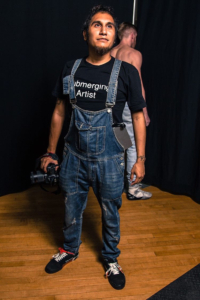 Faustino Vidal is a Brooklyn-based image-maker specializing in video and photography. In 2015, Vidal received a Bachelor of Arts with a focus in film and photography from Hampshire College; and in 2018, he graduated from the ICP-Bard Photography MFA program. Prior to this exhibit, his work has been featured in three solo shows.
Faustino Vidal is a Brooklyn-based image-maker specializing in video and photography. In 2015, Vidal received a Bachelor of Arts with a focus in film and photography from Hampshire College; and in 2018, he graduated from the ICP-Bard Photography MFA program. Prior to this exhibit, his work has been featured in three solo shows.
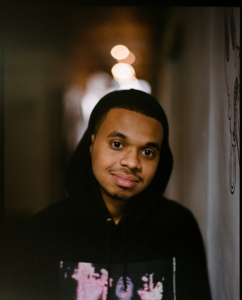 Jorge Romero is a Dominican photojournalist from New York. He graduated from The New School with a BA degree in Journalism + Design and an MA degree in Media Studies and Management. His work “Pelo Bueno, Pelo Malo” is a photographic commentary about the importance of hair within the Dominican community. The inspiration came from his childhood, where he and his sister were forced to have a certain kind of hairstyle.
Jorge Romero is a Dominican photojournalist from New York. He graduated from The New School with a BA degree in Journalism + Design and an MA degree in Media Studies and Management. His work “Pelo Bueno, Pelo Malo” is a photographic commentary about the importance of hair within the Dominican community. The inspiration came from his childhood, where he and his sister were forced to have a certain kind of hairstyle.
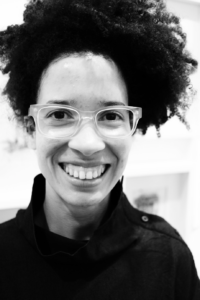 Leslie Jimenez is a Dominican-American artist and educator living in New York. Her work connects experiences of childhood, womanhood, motherhood, education, and life as a Caribbean American in New York. Jimenez creates drawings, site-specific murals, art installations, and prints. This series is about hair within the context of cultural notions of self-display, identity, ethnic awareness, and beauty.
Leslie Jimenez is a Dominican-American artist and educator living in New York. Her work connects experiences of childhood, womanhood, motherhood, education, and life as a Caribbean American in New York. Jimenez creates drawings, site-specific murals, art installations, and prints. This series is about hair within the context of cultural notions of self-display, identity, ethnic awareness, and beauty.
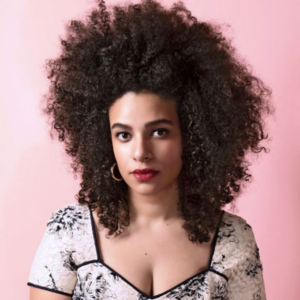 Yelaine Rodriguez is a Bronx-born Afro-Dominican American artist, educator, curator, and cultural organizer. She received a B.F.A. in Fashion Design from The New School (2013) and an M.A. in Latin American and Caribbean Studies/Museum Studies from New York University (2021). “The Political Afro” is a photo narrative of reimagined portraits of the styles of 1960s Civil Rights activists and leaders.
Yelaine Rodriguez is a Bronx-born Afro-Dominican American artist, educator, curator, and cultural organizer. She received a B.F.A. in Fashion Design from The New School (2013) and an M.A. in Latin American and Caribbean Studies/Museum Studies from New York University (2021). “The Political Afro” is a photo narrative of reimagined portraits of the styles of 1960s Civil Rights activists and leaders.
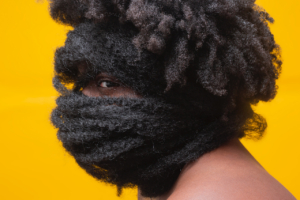
Vicky Charles, based in New York, has a BFA in Photography from SUNY New Paltz. Her work consists of self-portraits that deal with issues about black identity, the body, and relationships with oneself. Charles achieves her visual effects with such procedures as staged studio work and double exposures. Her photography expresses itself without words but by showing.
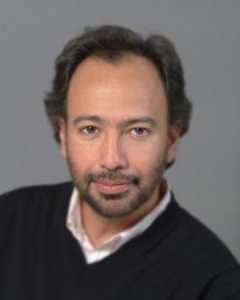
Michael Palma Mir, Curator
A lifelong and a second-generation resident of Harlem, Hamilton Heights, Mr. Palma Mir has been a community activist all his adult life. Mr. Palma Mir divides his time between work in the theater and photography as well as being an advocate for a better quality of life in West Harlem. Mr. Palma Mir is twice graduated from Columbia University with a BA in English and a Master of Fine Arts from the Hammerstein II Center. As a photographer, Mr. Palma Mir has documented cultural life in Upper Manhattan. since the 1980’s and has curated and participated in various Upper Manhattan photo groups. Most notably, he co-curated and participated in “Vague Terrain: Manhattanville” at the Compton-Goethals Hall Art Gallery in City College, where Mr. Palma Mir spent a year chronicling the architecture, artifacts, and people of Manhattanville; a photographic testimonial during a period of ongoing and dramatic changes for the community. More recently he curated a photo exhibit named “Selfless Selfies” at the Northern Manhattan Arts Alliance Gallery, a black & white photo exhibit by Upper Manhattan photographers, narrating stories about their changing communities. Mr. Palma Mir also conducts free photography workshops for the Fort Tryon Conservancy and for the Montefiore Park Neighbor Association and is the resident staff photographer to the Sugar Hill Children’s Museum of Art and Storytelling and El Museo del Barrio
About Hamilton Landmark Galleries
Originally conceived as an artist cooperative, Hamilton Landmark Galleries opened its doors in the autumn of 1997, its mission; dedicated to the presentation of fine art, the development of contemporary artists, and the documentation of fine art collections.
The Galleries has presented the work of more than seventy contemporary artists from the Americas, Africa, Asia, the Caribbean and Europe; painters, ceramists, sculptors, printmakers, muralists, graffiti and mixed media artists, and photographers. Periodically, HLG opens its doors for the enjoyment of other fine arts with readings from poets and playwrights and live musical concerts. The Galleries’ attraction to patrons is the positive spiritual aura that exudes from its state of the art viewing environment. HLG is situated in a landmark building erected in 1886 among a group of other buildings completed between 1886 and 1890. It represents one of the oldest structures in the district, a picturesque block in the village of Harlem’s Hamilton Heights historic district.
The future of Hamilton Landmark Galleries is to expand its cultural outreach to the community by hosting artists-in-residence, holding master classes, and building a permanent collection.
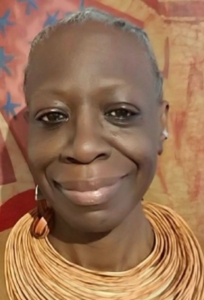
Kim Hamilton, Owner
Kim Hamilton is Director of Hamilton Landmark Galleries, a contemporary art gallery operating in Harlem since 1997. As a resident of Harlem for more than 40 years, she has witnessed the constriction of Harlem’s environmental, economic and cultural landscape and its resurgence as an iconic and representational New York neighborhood. She believes that all of New York’s inner city neighborhoods reflect one another, and she strives to be an example of creativity and health through social entrepreneurship during the last 10 years partnering with NOMAA and other institutions to elevate awareness of the “consciousness” of contemporary artists.
A self-taught visual artist and urban farmer, Ms. Hamilton was raised to be an activist, picketing against the centralization and segregation of New York Public Schools in 1962 as a second grader with her mom and siblings. In 1992 she went on to help write Procurement Policy under New York’s first Black Mayor, David Dinkins, secured work for dozens of entrepreneurs and small businesses through the South Bronx Overall Economic Development Corp programs, Medgar Evers College partnership with Bedford Stuyvesant Community Trust, and Bronx Council on the Arts Development Corp’s Art Handlers’ Training and African Burial Ground Projects. “
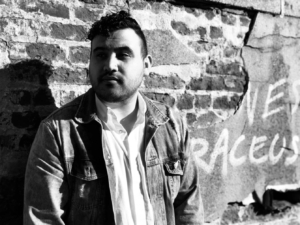
Oscar J Rivera was born in Brooklyn, New York, and studied photography at Parsons The New School for Design. His work covers a range of themes including personal relationships, sexuality and gender identity, as well his quest to define his latinidad. Rivera often creates bodies of work that incorporate found artifacts, vintage photographs, and his own work to create diaristic approaches to storytelling. He was previously a Studio Art Mentor with Studio in A School, and worked within several summer programs teaching art to Children in NYC public schools. Rivera received a scholarship to attend the National Conference on Race and Ethnicity in Higher Education to develop programming on campus at The New School. He currently is a Curator and Development manager with En Foco.
This exhibition is supported in part by public funds from the New York City Department of Cultural Affairs, in partnership with the City Council, New York State Council on the Arts with the support of Governor Andrew M. Cuomo and the New York State Legislature, Ford Foundation, The Lily Auchincloss Foundation, Joy of Giving Something, Inc., and private contributions. Member of the Urban Arts Cooperative.